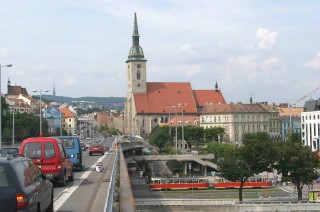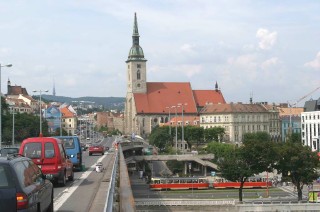St Martin’s Cathedral, Bratislava


Though it was consecrated and officially opened in 1452, it took nearly two centuries from ground-breaking to complete this Gothic cathedral. From 1563 it became the official coronation site for 11 Kings of Hungary during the Turkish occupation of Budapest. It also hosted the premiere of Beethoven’s Missa Solemnis.
The cathedral’s basic plan has three naves, with several chapels added from time to time over the centuries. Its most famous work of art is an 18th-century statue of St Martin and the Beggar.
With the Charter of 24 April 1204, Pope Innocent III permitted the transfer of the Chapter from Bratislava Castle to the town. However, not until 20 April 1221 did Pope Honorius ratify the application of the Head of the Ecclesiastical College to construct the cathedral.
Construction began after 1221, but in the mid 13th century the cathedral was badly damaged during the war between Hungary and Bohemian king Premysl Otakar II. Architectural expansion, to include today’s three-aisle church and sanctuary, began only during the 14th century. The vault was completed in 1452 and in that year the church was consecrated.
To the left of the sanctuary, added in 1729-1732, is the chapel of St John the Charitable, created by sculptor George Raphael Donner. Above the altar the remains of St John the Charitable are laid to rest in a silver coffin.
St Anne’s Chapel is located to the left of the north-faced aisle. Here may be found the entrance to the crypt, which branches out underneath the nave in the direction of Kapitul Street. A separate crypt underneath the chapel of St John the Charitable houses the remains of archbishops Emrich Esterházy (d 1745), Nicholas Csáky (d 1757), Frank Barkóczy (d 1765) and Joseph Batthyány (d 1799). Underneath the cathedral’s sanctuary is the crypt of the Pálffy family.
On the right side of the vestry lies the entrance to St Joseph’s Chapel and on the left side the entrance to the altar of the Virgin Mary. Above the vestry and along its right side is the Chapel of Czech Queen Sofia, which may also be accessed from St Joseph’s Chapel.
The vault of the sacristy is rack-shaped, with 23 bolts. These are embellished with heraldic arms of leading families, cities and countries which made contributions to the construction of the cathedral.
On the wall of the sacristy is a wall painting with inscriptions of some of the Hungarian kings and queens who were crowned in the cathedral.
Situated immediately below the cathedral tower, the sacristy contains a display of vestments, church furnishings, sacred vessels and other ecclesiastical artefacts from various stages of the cathedral’s history. A flight of stairs leads to an exhibition room containing more ecclesiastical vestments, manuscripts and silverware, including a priceless 15th-century Hungarian silver chalice.
The tower itself was originally part of the city fortifications and was destroyed on several occasions, only to be repeatedly restored. The last restoration was carried out in 1833.
The 85-metre tower is topped by a huge gold-plated representation of the Crown of St Stephen, which was placed there in 1847 to commemorate the cathedral's glory and importance as a coronation church. It weighs 300 kg, measures over 1 metre in diameter, and rests on a 2 x 2 metre gold-plated pillow. A total of 8 kg of gold was required to construct the crown and pillow.
Amongst the most significant Gothic monuments in the cathedral are the relief of the Holy Trinity, which dates from the 14th century, and the Tomb of Archbishop Georg Schomberg, Vice Chancellor of Academia Istropolitana, which was completed in 1470. These can be observed in St Anne’s Chapel.
At the southern aisle may be found the Gothic font, created in 1409, and the statue of St Martin and the Beggar, completed in 1734 by sculptor G R Donner and originally located in the sanctuary of the main altar. The present-day main altar, the work of Viennese master John Hutterer, was completed in 1864.
Today the fabric of is slowly deteriorating, mainly due to vibration caused by heavy traffic on the access ramp to the nearby bridge, Nový Most. Restoration efforts began in 1997 and the cathedral was declared a National Cultural Monument on 11 November 2002.
A small but significant neighbour of the cathedral is a monument to the synagogue which stood next door for centuries until the communist government demolished it around 1970 to make room for Nový most.
A festival entitled Korunovačné slávnosti (Coronation Feasts) has been held annually in the cathedral since 2003, commemorating the coronation of one of the kings.
